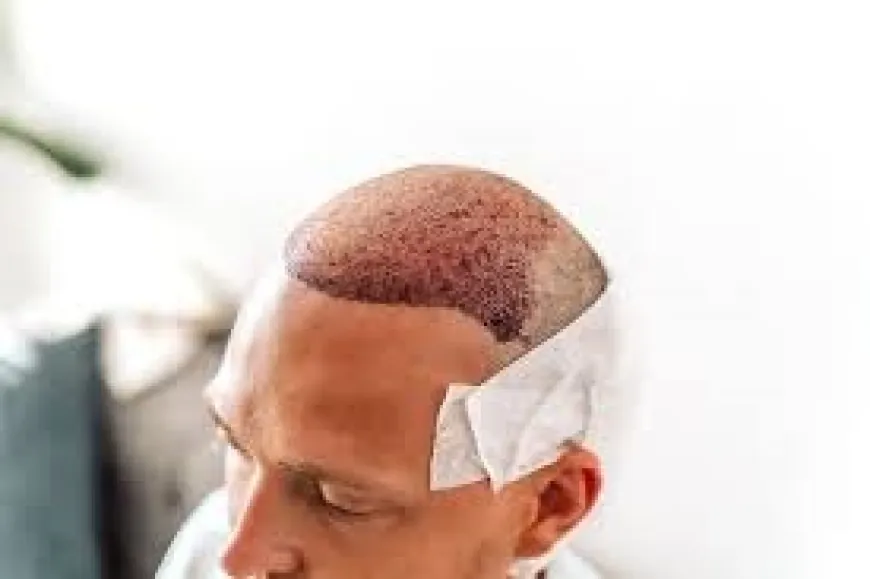How to Prepare for Your Hair Transplant in Dubai: A Step-by-Step Guide
Hair transplant in Dubai offers a permanent solution for hair loss, utilizing advanced techniques like FUE and FUT natural-looking hairline. With world-class clinics and experienced surgeons, Dubai is a leading destination for individuals seeking to regain their confidence and achieve a fuller, youthful appearance. The procedure is minimally invasive, ensuring quick recovery and long-lasting results, making it an ideal choice for those looking to transform their look with precision and care.

Getting a hair transplant is a life-changing decision that can help restore your hair and boost your confidence. If you’re considering undergoing this procedure in Dubai, you’re choosing one of the best destinations for hair restoration, thanks to its world-class clinics, expert surgeons, and state-of-the-art technology. However, like any medical procedure, proper preparation is key to ensuring that the process goes smoothly and you achieve the best possible results.
In this guide, we’ll walk you through the essential steps to prepare for your hair transplant in Dubai, from consultation to post-surgery care, so you can feel confident and ready for your journey to thicker, healthier hair.
1. Research and Choose the Right Clinic
The first and most important step in preparing for a Hair Transplant in Dubaiزراعة الشعر في دبي is selecting the right clinic. Dubai is home to numerous top-tier hair transplant clinics that offer a range of techniques, including FUE (Follicular Unit Extraction), FUT (Follicular Unit Transplantation), and DHI (Direct Hair Implantation). When choosing your clinic, consider the following factors:
- Surgeon’s Experience and Qualifications: Look for a clinic with experienced surgeons who are certified and specialize in hair restoration. Check their portfolio for before-and-after photos of previous patients.
- Technology and Techniques: Ensure the clinic uses the latest technology and techniques for hair transplants to achieve natural-looking, long-lasting results.
- Patient Reviews and Testimonials: Read online reviews, patient testimonials, and success stories to get an idea of the clinic's reputation and the experiences of previous patients.
- Consultation Process: A good clinic will offer a detailed consultation where you can ask questions, discuss your goals, and understand what to expect.
Once you’ve selected a clinic, schedule a consultation with the surgeon to discuss your specific needs and concerns.
2. Initial Consultation and Assessment
Before undergoing a hair transplant, you’ll have an initial consultation with the surgeon to assess your hair loss, medical history, and suitability for the procedure. During this consultation, the surgeon will:
- Evaluate Your Hair Loss: The surgeon will assess the extent of your hair loss, the condition of your donor area (usually the back of your head), and determine if you're a good candidate for the procedure.
- Create a Treatment Plan: Based on your goals and hair loss pattern, the surgeon will recommend the most suitable hair transplant technique for you (FUE, FUT, DHI, etc.).
- Set Realistic Expectations: The surgeon will explain what results you can expect, how long recovery will take, and any potential risks or side effects.
This consultation is also the perfect opportunity to ask any questions you may have about the procedure, recovery, costs, or aftercare. It’s important to feel comfortable and confident with the surgeon and the clinic.
3. Follow Pre-Procedure Guidelines
In the days leading up to your hair transplant procedure, your surgeon will provide you with specific pre-operative instructions. Following these guidelines is crucial for ensuring the best results and minimizing complications. Some common pre-procedure guidelines include:
- Avoid Alcohol and Smoking: It’s important to refrain from consuming alcohol and smoking at least 7-10 days before your surgery. These substances can interfere with the healing process and affect the results of the transplant.
- Discontinue Certain Medications: Certain medications, such as blood thinners, may need to be temporarily discontinued before your hair transplant. Be sure to inform your surgeon about any medications you are taking.
- Get a Good Night’s Sleep: Ensure you are well-rested before the procedure. A full night’s sleep will help you feel more relaxed and ready for the surgery.
- Avoid Blood Thinners: Avoid taking over-the-counter medications like aspirin or other blood-thinning medications unless approved by your surgeon.
- Shampoo and Clean Your Scalp: On the morning of the procedure, wash your hair and scalp thoroughly with a mild shampoo. This helps remove oils and dirt, ensuring a clean and healthy environment for the transplant.
4. Arranging Transportation and Support
Since the hair transplant procedure can take several hours, and you may be under local anesthesia, it’s essential to plan for transportation after the surgery. Most patients feel fine post-procedure but should avoid driving themselves home. Arrange for a friend, family member, or taxi to drive you back to your accommodation after the surgery.
Additionally, having someone to accompany you during the recovery phase can be helpful, especially during the first few days after the transplant when you may need assistance with medications or daily activities.
5. Prepare for Post-Surgery Care
Understanding the post-operative care instructions is a key part of preparing for your hair transplant. After your procedure, it’s essential to follow the instructions closely to ensure proper healing and optimal results. These may include:
- Taking Medications: Your surgeon may prescribe medications to prevent infection or manage pain and inflammation. Be sure to take them as directed.
- Avoid Touching or Scratching the Scalp: After the transplant, you’ll need to avoid touching, scratching, or rubbing the transplanted area to prevent dislodging the grafts.
- Washing Your Hair: Your surgeon will give you specific instructions on how to wash your hair post-surgery. Generally, you’ll need to wait a few days before washing your hair to allow the grafts to settle in.
- Wearing a Soft Hat: After the procedure, you may be instructed to wear a soft hat or headband to protect the grafts during the healing process.
- Avoid Physical Activity: Avoid strenuous exercise or physical activities for at least a week post-surgery to prevent sweating and unnecessary stress on your scalp.
6. Plan for Downtime and Recovery
After your hair transplant in Dubai, you may experience mild swelling, redness, or scabbing in the donor and recipient areas. These are common and temporary side effects that typically subside within a few days. Most patients are able to return to work and regular activities within 3-7 days, but it’s important to avoid activities that could disrupt the healing process, such as intense exercise, swimming, or exposure to direct sunlight.
During the recovery period, patience is key. It may take several months before you start seeing noticeable hair growth, and full results can take up to a year. Follow-up consultations with your surgeon will help track your progress and ensure everything is healing as expected.
Conclusion
Proper preparation for your hair transplant in Dubai is crucial to ensuring a successful procedure and achieving the best results. By researching and selecting the right clinic, following pre-procedure guidelines, and being prepared for post-surgery care, you can ensure a smooth experience and a significant improvement in your appearance and confidence.
With the help of Dubai’s top hair transplant experts, you’re taking the first step toward restoring your hair and regaining your self-esteem. If you follow the preparation tips outlined above, you’ll be well on your way to enjoying a fuller, thicker head of hair that looks natural and enhances your overall appearance.
What's Your Reaction?
 Like
0
Like
0
 Dislike
0
Dislike
0
 Love
0
Love
0
 Funny
0
Funny
0
 Angry
0
Angry
0
 Sad
0
Sad
0
 Wow
0
Wow
0
















































